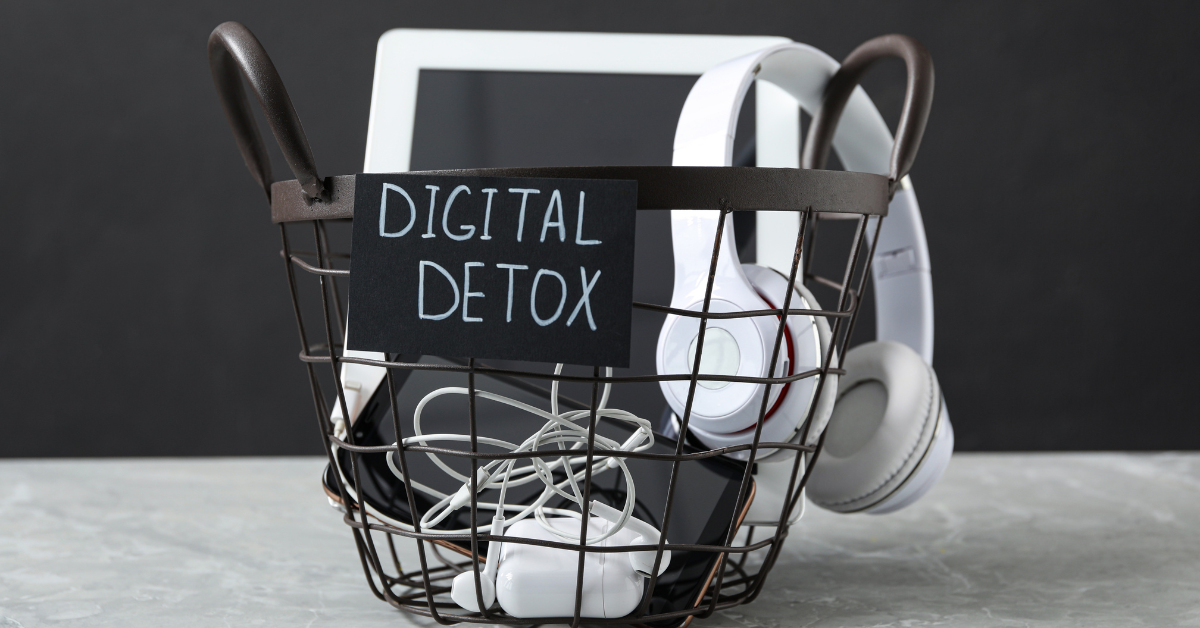In our hyper-connected world, screens have become an essential part of daily life. While technology has its benefits, constant digital connectivity can lead to stress, mental fatigue, and even a sense of digital dependency. If you often find yourself scrolling aimlessly, feeling anxious from notifications, or struggling to focus without checking your phone, a digital detox might be the solution.
This article explores what a digital detox is, why it’s beneficial, and offers practical steps to reduce screen time, reclaim mental clarity, and improve overall well-being. By incorporating small changes, you can restore balance and enjoy a healthier relationship with technology.
Understanding the Need for a Digital Detox
What is a Digital Detox?
A digital detox is a conscious break from electronic devices, such as smartphones, computers, and social media, with the goal of reducing stress and improving focus. This intentional disconnect allows you to reset, recharge, and reconnect with yourself and the people around you. Digital detoxes range from setting screen time boundaries to taking longer breaks from social media or all devices.
Taking time away from screens can improve mental health, boost productivity, and create a greater sense of mindfulness in daily life.
The Impact of Constant Connectivity on Mental Health
Constant connectivity can take a toll on mental health. Research links excessive screen time to increased anxiety, sleep disturbances, and difficulty concentrating. A significant amount of screen time is also associated with social comparison and lower self-esteem, especially in the context of social media. Moreover, the blue light emitted by screens can disrupt sleep, affecting the body’s natural circadian rhythms.
Understanding the impact of digital overload can highlight the benefits of taking regular digital breaks and engaging in more intentional, present-moment activities.
To learn about the effects of information overload and how to manage it, explore Digital Overload: Causes andSolutions from Resilience Lab. This guide examines the impact of constant connectivity and offers practical tips to reduce stress and mental fatigue.
Signs You Might Need a Digital Detox
It can be challenging to recognize when screen time becomes excessive, but there are common signs of digital overload. If you feel anxious without your phone, frequently check your devices out of habit, or experience physical symptoms like eye strain or headaches, it may be time for a digital detox. Other signs include feeling constantly distracted, struggling to concentrate, or using screens as a primary way to relieve stress.
By identifying these signs, you can take steps toward a healthier balance with technology, improving focus and mental clarity.

Benefits of a Digital Detox
Improved Focus and Productivity
One of the main benefits of a digital detox is improved focus. Frequent notifications and digital distractions make it difficult to stay concentrated on tasks, leading to multitasking and reduced productivity. A digital detox allows you to regain control over your time and focus, leading to more efficient and productive work or study sessions.
Without constant interruptions, you’ll likely find that you can accomplish tasks more effectively, giving you more time to relax and recharge.
Better Mental Health and Reduced Anxiety
A break from screens can have a positive impact on mental health, reducing anxiety and promoting a calmer state of mind. By stepping away from digital devices, you reduce exposure to information overload, social comparison, and the pressure of constant connectivity. Digital detoxes also encourage more mindful interactions with technology, helping you engage with digital content purposefully rather than passively.
This reduced reliance on screens fosters a greater sense of peace, allowing you to focus on meaningful activities that contribute to well-being.
For insights into the benefits of disconnecting, explore Health Benefits of Reducing Screen Time and the Toxicity ofSocial Media from ChiroHealth & Wellness. This article highlights how limiting screen time can improve mental and physical well-being.
Enhanced Relationships and Social Connections
Taking a break from screens allows for more meaningful face-to-face interactions, strengthening relationships and improving communication. Digital detoxes create opportunities for quality time with friends, family, or even solo activities that foster self-connection. By being fully present, you can enjoy richer interactions, free from digital distractions.
Over time, these moments of real-life connection enhance personal relationships, contributing to a greater sense of fulfillment and happiness.

Practical Steps to Start a Digital Detox
1. Set Boundaries for Screen Time
Setting boundaries for screen time is an effective first step in a digital detox. Try setting daily or weekly screen time limits using apps that monitor usage. Many devices now offer “Digital Wellbeing” or “Screen Time” settings to help track and limit screen use. Consider creating specific no-screen periods, such as an hour before bed or during meals, to help reset your focus.
Setting screen time boundaries helps you use technology intentionally, allowing you to enjoy both online and offline activities.
2. Designate Tech-Free Zones in Your Home
Creating tech-free zones in your home can help reduce mindless screen use and create spaces for relaxation and conversation. Designate areas like the bedroom, dining room, or living room as tech-free to promote better sleep, family bonding, or personal time. These zones act as reminders to unplug, allowing you to fully enjoy non-digital activities.
Making certain areas tech-free also helps create a more balanced living environment, reinforcing healthier digital habits over time.
For tips on managing technology use in children, explore Navigating Screen Time: Creating Healthy Digital Habitsfor Kids from Nurture Infant. This guide offers practical strategies for promoting balanced and mindful screen time for your little ones.
3. Turn Off Notifications
Notifications are a major source of distraction and stress. By turning off non-essential notifications, you reduce interruptions and regain control over your focus. Consider keeping only critical notifications, like calls or essential emails, while disabling alerts from social media or non-urgent apps. Many devices offer “Do Not Disturb” or “Focus” modes to help manage notifications during work or downtime.
By controlling notifications, you create a calmer digital experience that supports both productivity and relaxation.

Activities to Replace Screen Time
Engage in Physical Exercise
Exercise is an excellent alternative to screen time, offering benefits for both physical and mental health. Physical activity helps release endorphins, which improve mood and reduce stress. Whether it’s a walk, yoga session, or workout, exercise provides a screen-free way to recharge and feel more energized.
Incorporating exercise into your daily routine can also improve sleep quality, giving you a greater sense of balance and well-being.
Pick Up a New Hobby or Creative Outlet
Hobbies and creative activities provide a mental break from screens, allowing you to focus on something fulfilling and hands-on. Consider trying activities like painting, cooking, gardening, or reading. Hobbies stimulate the mind in different ways than screens do, providing relaxation and a sense of accomplishment.
By exploring new interests, you can reduce screen reliance while enjoying mentally stimulating and rewarding experiences.
Practice Mindfulness and Meditation
Mindfulness and meditation are powerful tools for reducing digital dependence and enhancing mental clarity. Simple practices like deep breathing, guided meditation, or mindfulness exercises help calm the mind and shift focus away from screens. Taking just a few minutes to practice mindfulness throughout the day can improve focus, reduce stress, and provide a mental reset.
As part of a digital detox, mindfulness can be a transformative practice for mental clarity and overall well-being.

Maintaining Balance with Technology Post-Detox
Creating a Sustainable Screen Time Routine
After completing a digital detox, create a sustainable screen time routine to maintain a balanced relationship with technology. Try implementing scheduled digital breaks, tech-free evenings, or screen-free Sundays to keep your habits in check. Establishing a routine ensures that you continue enjoying the benefits of reduced screen time while staying connected as needed.
By creating a screen time routine, you can integrate intentional device use into your life without feeling overwhelmed.
Developing Digital Mindfulness
Digital mindfulness involves being intentional with your device use, allowing you to stay present and reduce mindless scrolling. Instead of opening apps out of habit, set specific times for checking social media or emails. By being mindful, you become more aware of how you spend your time online, helping you avoid compulsive device checking and unnecessary distractions.
Digital mindfulness empowers you to engage with technology purposefully, enhancing your mental clarity and overall experience.
Setting Personal Goals for Balanced Digital Use
Setting personal goals for digital balance helps you stay accountable. Consider goals like limiting social media to a set amount of time per week or designating one day a month as a tech-free day. These goals help reinforce healthy habits and keep screen time in check.
Over time, these small, consistent steps lead to a more balanced and fulfilling relationship with technology, allowing you to enjoy its benefits without feeling overwhelmed.
For practical ways to improve mental clarity and well-being, explore our guide on Digital Detox Benefits. Discover how stepping away from screens can reduce stress and help you reconnect with what matters most.

Conclusion
A digital detox can be a refreshing way to reclaim your time, improve mental clarity, and strengthen personal connections. By taking intentional steps to reduce screen time, you give yourself the opportunity to reconnect with the world around you, manage stress, and improve focus. Start with small changes, like setting screen time boundaries and creating tech-free zones, and gradually build habits that support a healthier digital life.
Whether you’re looking for greater peace of mind, enhanced productivity, or stronger relationships, a digital detox offers lasting benefits. Embrace the power of unplugging, and enjoy a renewed sense of balance and well-being.




















